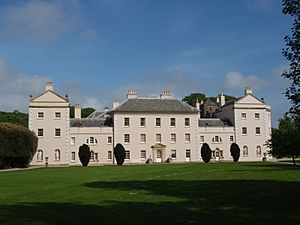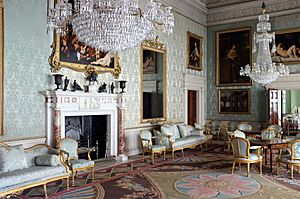Saltram House facts for kids
Quick facts for kids Saltram House |
|
|---|---|

Saltram House, east front; The central block with Venetian window contains the Saloon.
|
|
| Etymology | Salt was harvested on the nearby estuary and the fact that a "ham", or homestead, was on the site before the Tudor period |
| General information | |
| Status | Complete |
| Town or city | Plymouth |
| Country | United Kingdom |
| Coordinates | 50°22′54″N 4°04′57″W / 50.38167°N 4.08250°W |
| Owner | National Trust |
| Designations | |
|
Listed Building – Grade I
|
|
| Official name: Saltram House | |
| Designated: | 23 April 1952 |
| Reference #: | 1386230 |
Saltram House is a grand old house in Plympton, Devon, England. It's a Grade I listed building, which means it's very important historically and architecturally. A famous expert named Nikolaus Pevsner called it "the most impressive country house in Devon."
The house was designed by the famous architect Robert Adam. He made big changes and additions to an older Tudor house. The Saloon, a large drawing room, is thought to be one of Adam's best designs. Saltram is one of Britain's best-preserved examples of an early Georgian house. It still has many of its original decorations, plasterwork, and furniture. The house also holds a large collection of paintings belonging to the Parker family. These include several works by Sir Joshua Reynolds, a famous painter who was born nearby and was a friend of the Parker family.
The building you see today was started by John Parker (1703–1768) and his wife Catherine. Their son, John Parker, 1st Baron Boringdon, finished it. The Parker family became important in the mid-1500s.
The Saltram Estate was given to the National Trust in 1957. This means it's now looked after by a charity and is open for everyone to visit and enjoy.
Contents
What's in a Name?
The name Saltram comes from two things. First, "salt" was collected from the nearby river mouth (estuary). Second, "ham" means a homestead or small village. So, it was a place where salt was found, and there was a settlement there even before the Tudor period.
A Look Back in Time
Early Owners
The first family known to own Saltram was the Mayhew family in the 1500s. They were farmers and owned Saltram for about 50 years. They had a lot of land, including woods, buildings, and even fishing rights.
Next, the Bagg family took over. They likely turned the farmhouse into a bigger mansion. Sir James Bagg, a local leader and Mayor of Plymouth, bought Saltram around 1614. His son, James II Bagg, inherited the house. He was a deputy governor and worked closely with powerful figures.
Challenges and Changes
James II Bagg's son, George Bagg, inherited Saltram in 1638. At that time, Saltram was described as having a "great mansion house," stables, gardens, orchards, and meadows. George Bagg supported the King during the English Civil War. Because of this, Saltram was damaged by the Parliamentarian forces. After the King's side lost, George Bagg had to pay a large fine to keep his land.
Even after surviving the Civil War, the Bagg family lost Saltram in 1660. The government gave it to Henry Hatsell to pay off a debt owed by Bagg. However, when the King returned to power later that year, Hatsell lost the estate. It was then given to Sir George Carteret to settle a loan he had given to the King.
In 1712, George Parker bought Saltram. His family, the Parkers, then owned Saltram for many years, making it the grand estate it is today.
How Saltram House Grew
Making it Grand
John Parker inherited the house in 1743. With his wealthy wife, Lady Catherine Parker, he began to make the house much grander. They added balanced, elegant fronts to the building, which hid its older Tudor beginnings. Inside, they added beautiful, delicate plasterwork on the ceilings in rooms like the Entrance Hall.
Their son, also named John Parker, took over in 1768. A year later, he married Theresa Robinson. While her husband enjoyed other activities, Theresa, her sister, and brothers were very interested in decorating the house. Theresa is often given credit for making Saltram a "showpiece of South West England." The six years before Theresa's early death are seen as Saltram's best period. The house has ten portraits painted by Joshua Reynolds.
In 1768, Robert Adam was hired to design the Saloon and the Library (which is now the Dining Room). Adam designed everything, from the door handles to the huge plasterwork ceiling. Famous furniture maker Thomas Chippendale created furniture for the house, and Matthew Boulton made four candelabras. Theresa and her husband spent a lot of money, about £10,000, on the Saloon alone!
The parkland around the house was also designed during this time by Nathaniel Richmond.
Later Years and New Additions
The third John Parker, later known as the Earl of Morley, inherited the house in 1788. In 1819, he hired an architect named John Foulston to add the Entrance Porch. Foulston also combined two smaller rooms to create the current Library. The Earl's second wife, Frances, was an artist. She created her own watercolors and copied famous old paintings, which are still displayed in the house. The Earl tried to start several industrial projects on the estate, but many didn't work out, and the family ended up with a lot of debt.
Becoming a National Treasure
Money became so tight that Albert Parker, 3rd Earl of Morley, had to leave the house for many years, from 1861 to 1884. He could only return after selling some of the estate's most valuable paintings. The family's luck improved in 1926 when Edmund Parker, 4th Earl of Morley, inherited other estates. However, these good times didn't last long, as the war caused some damage to the house from bombing.
Finally, in 1957, Saltram House and its contents were given to the National Trust instead of paying taxes. This made sure the house would be preserved for everyone to enjoy. In May 2024, the house was featured in a BBC documentary series called Hidden Treasures of the National Trust.
The Beautiful Landscape
Saltram House is located near the Laira estuary, where the river meets the sea. Because it's tidal, the view changes between water and mudflats. A nearby landfill site, Chelson Meadow, has been turned into a green space. From the first floor of the house and the Castle summerhouse in the gardens, you can see views of Plymouth Sound.






